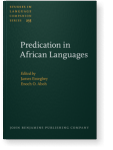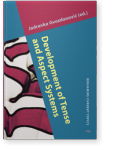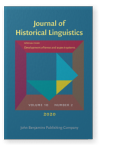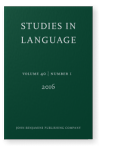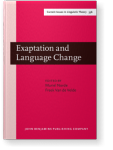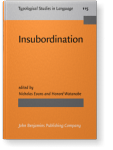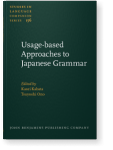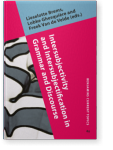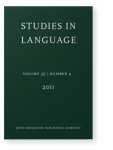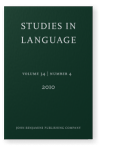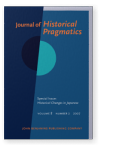Heiko Narrog
List of John Benjamins publications for which Heiko Narrog plays a role.
Book series
Titles
Perspectives on Semantic Roles
Edited by Silvia Luraghi and Heiko Narrog
[Typological Studies in Language, 106] 2014. vi, 336 pp.
Subjects Semantics | Syntax | Theoretical linguistics | Typology
Modality in Japanese: The layered structure of the clause and hierarchies of functional categories
Heiko Narrog
[Studies in Language Companion Series, 109] 2009. xxii, 277 pp.
Subjects Functional linguistics | Japanese linguistics | Semantics | Syntax | Theoretical linguistics
2022 Historical change in the Japanese tense-aspect system Development of Tense and Aspect Systems, Gvozdanović, Jadranka (ed.), pp. 143–178 | Chapter
2020 Chapter 3. The scope of modal categories: An empirical study Re-Assessing Modalising Expressions: Categories, co-text, and context, Hohaus, Pascal and Rainer Schulze (eds.), pp. 47–78 | Chapter
This paper investigates the scope of modal categories. While it is hypothesized in many linguistic theories that different modal categories have different scope, there are only very few systematic studies that show differences. The language of investigation is Japanese, which has grammaticalized… read more
2020 Chapter 7. Modal marking in conditionals. Grammar, usage and discourse Re-Assessing Modalising Expressions: Categories, co-text, and context, Hohaus, Pascal and Rainer Schulze (eds.), pp. 173–194 | Chapter
This paper investigates modal marking in conditionals with respect to two research questions: (1) How tightly integrated are conditional sentences, both relative to similar adverbial clause constructions, and with respect to different variants of conditional constructions. (2) What are the… read more
2020 Historical change in the Japanese tense-aspect system Development of tense and aspect systems, Gvozdanović, Jadranka (ed.), pp. 289–324 | Article
Modern Japanese has a formally very simple tense-aspect system, which at its core has only three forms that are complemented by a number of peripheral markers and constructions. The core of the tense-aspect system was much more elaborate and complex in Classical Japanese. This paper discusses the… read more
2016 Constructional change vs. grammaticalization: From compounding to derivation Studies in Language 40:1, pp. 137–175 | Article
Building on recent findings made in the framework of Construction Grammar, on the one hand, and within the framework on grammaticalization, on the other, the present paper is concerned with the development from lexical compounding to derivation. Compounding is presumably the most common source of… read more
2016 Exaptation in Japanese and beyond Exaptation and Language Change, Norde, Muriel and Freek Van de Velde (eds.), pp. 93–120 | Article
An increasing amount of specific phenomena have been identified as exaptation in a variety of languages, but mainly of the Indo-European stock, and mainly concentrating on a specific example of the phenomenon. Furthermore, there is considerable disagreement about how the concept should be applied… read more
2016 Chapter 10. Insubordination in Japanese diachronically Insubordination, Evans, Nicholas and Honoré Watanabe (eds.), pp. 247–282 | Article
This chapter is designed to give an overview of insubordination in documented Japanese language history, that is, not including pre-history and reconstruction. While doing so, a number of important issues concerning insubordination are discussed, including borderline cases between insubordination… read more
2014 What typology reveals about modality
in Japanese: A cross-linguistic perspective* Usage-based Approaches to Japanese Grammar: Towards the understanding of human language, Kabata, Kaori and Tsuyoshi Ono (eds.), pp. 109–134 | Article
This paper presents a functional-typological analysis of three linguistic manifestations of modality-related phenomena in Japanese. When compared with English, German, and Korean, Japanese is characterized by a modal system that encodes event, epistemic, and evidential modalities, and a relatively… read more
2014 Perspectives on semantic roles: An introduction Perspectives on Semantic Roles, Luraghi, Silvia and Heiko Narrog (eds.), pp. 1–22 | Article
2014 Beyond intersubjectification: Textual uses of modality and mood in subordinate clauses as part of speech-act orientation Intersubjectivity and Intersubjectification in Grammar and Discourse: Theoretical and descriptive advances, Brems, Lieselotte, Lobke Ghesquière and Freek Van de Velde (eds.), pp. 29–51 | Article
This paper discusses textual uses of modality and mood forms in English and Japanese and claims that they represent a shift from subjective through intersubjective to the textual. As the shift towards textual function is difficult to define in terms of either subjectification or… read more
2014 The grammaticalization chain of case functions: Extension and reanalysis of case marking vs. universals of grammaticalization Perspectives on Semantic Roles, Luraghi, Silvia and Heiko Narrog (eds.), pp. 69–98 | Article
In the 1980s and 1990s, grammaticalization research brought forth a number of intriguing proposals concerning the directionality of extension and change between case functions, i.e. semantic roles. One of these proposals, by Heine et al. (1991), consisted in a single unidirectional chain of… read more
2013 Chapter 13. Grammaticalization of space in Korean and Japanese Shared Grammaticalization: With special focus on the Transeurasian languages, Robbeets, Martine and Hubert Cuyckens (eds.), pp. 287–316 | Chapter
Spatial concepts are central for human language and cognition. They can either be the source or the target of grammaticalizations. In this paper, we compare grammaticalization in Japanese and Korean in four core areas related to space: case particles and related particles, relational nouns,… read more
2012 Beyond intersubjectification: Textual uses of modality and mood in subordinate clauses as part of speech-act orientation Intersections of Intersubjectivity, Brems, Lieselotte, Lobke Ghesquière and Freek Van de Velde (eds.), pp. 29–52 | Article
This paper discusses textual uses of modality and mood forms in English and Japanese and claims that they all represent a shift from subjective through intersubjective to the textual. As the shift towards textual function is difficult to define in terms of either subjectification or… read more
2011 Review of Van Linden, Verstraete & Davidse (2010): Formal evidence in grammaticalization Studies in Language 35:4, pp. 913–926 | Review
2008 A note on modality and aspect in Saramaccan Modality–Aspect Interfaces: Implications and typological solutions, Abraham, Werner and Elisabeth Leiss (eds.), pp. 359–368 | Article
This article provides a short overview over Saramaccan TMA marking and its modal system and discusses the interaction of modality and aspect. Saramaccan modal markers are stative themselves and therefore do not take durative marking. However, differences appear when modal markers take propositions… read more
2008 The aspect-modality link in the Japanese verbal complex and beyond Modality–Aspect Interfaces: Implications and typological solutions, Abraham, Werner and Elisabeth Leiss (eds.), pp. 279–307 | Article
This contribution investigates the aspectual and modal marking in the Japanese verbal complex, and as a result offers support for the hypothesis of a link between aspect and deontic vs. epistemic interpretation of modal markers. Since Japanese is structurally largely different from the Germanic and… read more
2007 Modality and grammaticalization in Japanese Historical Changes in Japanese: Subjectivity and intersubjectivity, Onodera, Noriko O. and Ryoko Suzuki (eds.), pp. 269–294 | Article
Grammaticalization of modal markers has long been thought of in terms of change from deontic to epistemic meaning. This change, then, is typically thought of as a mapping between conceptual domains. Contrary to this perception, I argue in this paper that (1) change from deontic to epistemic (that… read more
2004 From transitive to causative in Japanese: Morphologization through exaptation Diachronica 21:2, pp. 351–392 | Article
Modern Japanese has a morphological causative, formed by suffixes on the verb, and lexical causatives. The morphological causative has been in use since Late Old Japanese. However, the etymology of this morphological causative and the status of related causative formations in Old Japanese remain… read more
